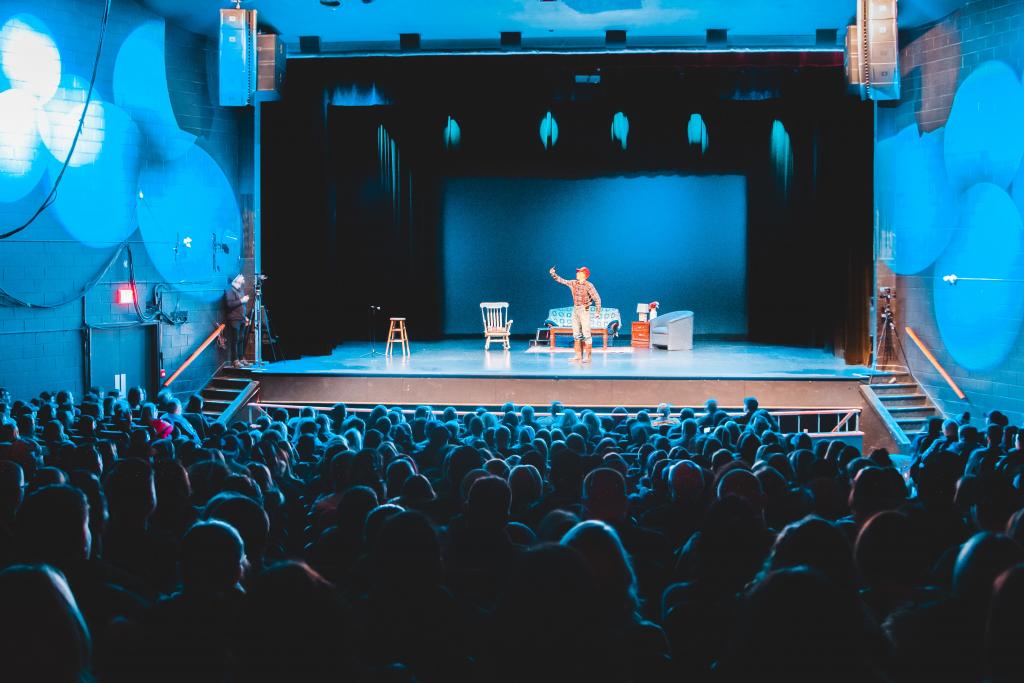When I started this blog, I intended to write about life as a Catholic theater artist in New York. Now, you’d be hard pressed to identify me as a playwright without reading my bio. Theater has been shut down for a year. My theater company has just planned our virtual season for 2021. I have mixed feelings about it. Theater artists have managed to create some innovative work over the past year. Online streaming of readings and airings of live performances have made theater more accessible than ever before. Some artists now believe that live streaming is the way of the future, that theater has fundamentally changed. I feel the opposite. The innovations of 2020 are superficial at best, and live theater is simply hibernating.

Live Theater as a “Lagging Art”
The first thing my undergraduate theater history professor told us has always stuck with me:
“If you are being chased by a bear every day, you don’t stop to make a play.”
Essentially, what this means is that theater, unlike music or fine art, only thrives when a society has reached a certain threshold of stability. It requires time, rehearsal, a degree of safety, and the ability to gather. Theater is a “lagging art” – it tends to come after the events which it reflects. Contrast this with music, is often written in the moment about emotions the artist is currently experiencing. Plays require reflection time. Creators need to time to process an experience before they can develop enough insight to adequately present it onstage.
The upside of all this is that it shouldn’t be a surprise that theater has halted during the pandemic. The obvious health risks aside, our society is not stable enough to support new play development. This is deeply sad, but it does mean that we can expect it to return as the disease declines, the economy stabilizes, and we are able to take a step back and reflect upon what we have experienced. The best plays about the pandemic have not yet been written. Some day, live plays will help us collectively process and heal. But I do have some serious concerns.
The Perils of Insularity
In addition to being a lagging art, theater has historically been a popular art. It was something for the masses. Now, it is increasingly something for the elite. By elite, I don’t necessarily mean wealthy. I do mean educated and equipped with a certain amount of historical theater context. To put it bluntly, during the pandemic us theater artists have spent a lot of time putting on Zoom plays for each other. On one hand, this is fine. We just want to keep busy, keep our creative juices flowing and our wits sharp. It’s not that important whether the quality of our work is high – we’re just playing. But on another hand, I’ve been deeply disturbed by the number of my peers who seem to think this is great. Zoom plays, they argue, democratize theater my making it easily available to all. Unfortunately, the general population is not particularly interested. And why should they be?
Before COVID, I used to perform most of my work in a little theater on the second floor of a building on 34th street. The place had no air conditioning, so it wasn’t a very pleasant experience for the audience. And, being on the second floor, it’s not like people were wandering in off the street. You kind of had to know where to go. But this wasn’t a result of not caring about reaching general audiences. It was simply the best space we could afford. Theater artists should want to perform plays for people who are not themselves artists. This is a given. Instead, we have spent the pandemic patting ourselves on the back for our digital work which – I have to be honest – is for the most part unwatchable. This is no way for theater to continue.
Should Streaming Continue?
As Terry Teachout describes in his recent article Theater After the Pandemic, there have been some positive changes to live theater in the pandemic. Airing Broadcasts of live performances – which, to be clear, is different than Zoom plays – can expand a theater’s footprint and allow more people to see work. But, at the end of the day, theater viewed on a screen is just bad television. There is no way to capture the immediacy of a theatrical experience on a livestream. Even if there’s no air conditioning in the theater. Even if the chairs are squeaky and the lights flicker. That’s kind of the point.
Teachout writes:
“For my part, my year without live theater has given me a fuller and more fervent appreciation of its indispensability. By bringing audiences together to take part in collective acts of truth and beauty, theater affords us a secular communion of souls that speaks to something fundamental in the human heart: It reveals us to one another and to ourselves.”
So should theaters continue streaming? If theaters think they can reach a few more people that way I suppose so. But it doesn’t change much. Live theater can’t be improved through digital streaming. And we can’t just do work for ourselves.
All we can do is wait. Because it’s just better in person.












